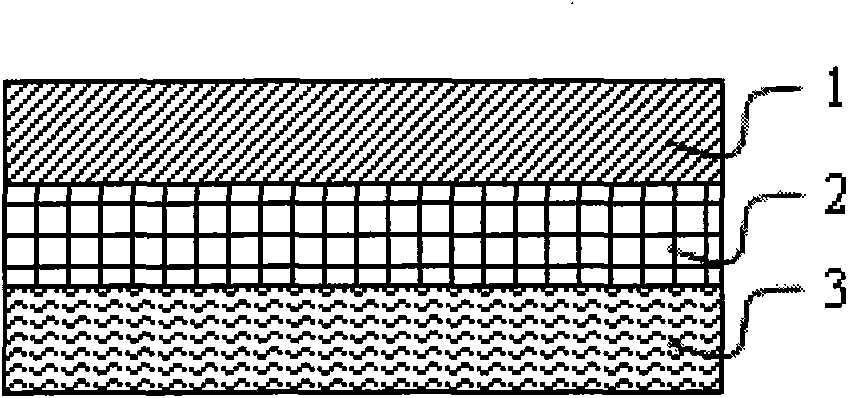Flame retardant multi-layer label
A flame-retardant layer and label technology, applied in the field of halogen-free flame-retardant multi-layer labels, can solve the problems of inability to use, generate smoke and toxic substances, and cannot meet halogen-free requirements, and achieve good printability and excellent flame retardant performance. Effect
- Summary
- Abstract
- Description
- Claims
- Application Information
AI Technical Summary
Problems solved by technology
Method used
Image
Examples
Embodiment 1
[0086] The preparation of the label of structure shown in Fig. 1: the top coating solution roll-coating (roll-coating) is on the first surface of base film, then is dried at 150 ℃ for 2 minutes to form top coating on the first surface of base film layer.
[0087] According to the method described above, 12 labels were obtained with 6 base films and two topcoat solutions (topcoat solutions 1 and 2). The six base films are PI, PEI, FR-PC, FR-PET, A1 and PVF. Topcoat solutions 1 and 2 were prepared according to the following method. Topcoat solution 1 was used to form a topcoat without a flame retardant (Non-FR topcoat), and topcoat solution 2 was used to form a topcoat with a flame retardant (FR topcoat).
[0088] Preparation of top coat solution 1: in a high shear mixer (Cowles TM ), 40 g of phenoxy resin (Inchem PKHH) and 60 g of polyurethane resin (Lubrizol Estane 5703) were dissolved in 450 ml of cyclohexanone at room temperature, 80 g of titanium dioxide (Dupont Ti-PureR...
Embodiment 2
[0095]The preparation of the label of the structure shown in Figure 2: roll-coat the top coat solution on the first surface of the base film, dry at 150°C for 2 minutes to form a top coat on the first surface of the base film, and then apply the adhesive The agent layer solution was roll-coated on the second surface of the base film, and dried at 90° C. for 4 minutes to form an adhesive layer on the second surface of the base film.
[0096] According to the above method, with 6 kinds of base films and two kinds of topcoat solutions 1 and 2 described in Example 1 and an acrylic adhesive for forming a non-flame retardant adhesive layer (non-FR adhesive layer) (National Starch, Durotak 180-129A) received 12 labels. The obtained labels were tested according to the UL94VTM-0 standard, and the results are shown in Table 2.
[0097] Table 2: Flame Retardancy Properties of Labels with Adhesive Layers Without Flame Retardant
[0098]
[0099] From Table 1 and Table 2, it can be se...
Embodiment 3
[0101] Using the same materials and methods as described in Example 2, a typical topcoat thickness (18 microns), flame retardant-free adhesive layer thickness (20 microns) and varying PI base film thicknesses were prepared accordingly. Label. The flame retardant properties of the obtained labels are shown in Table 3.
[0102] Table 3: Effect of base film thickness on flame retardant properties
[0103] PI thickness (micron)
[0104] It can be seen from Table 3 that for the PI base film, the thicker the base film, the better the flame retardancy. Typically, the base film thickness can be between 12 and 125 microns. Films that are too thin may be prone to breaking under tension and curling due to electrostatic attraction. Meanwhile, a film that is too thick is difficult to wind the battery and has cost problems. This thickness is preferred since PI with a thickness of 25 μm has higher mechanical stability than thinner ones and better adaptability to wound batteries...
PUM
| Property | Measurement | Unit |
|---|---|---|
| thickness | aaaaa | aaaaa |
| thickness | aaaaa | aaaaa |
| glass transition temperature | aaaaa | aaaaa |
Abstract
Description
Claims
Application Information
 Login to View More
Login to View More - R&D
- Intellectual Property
- Life Sciences
- Materials
- Tech Scout
- Unparalleled Data Quality
- Higher Quality Content
- 60% Fewer Hallucinations
Browse by: Latest US Patents, China's latest patents, Technical Efficacy Thesaurus, Application Domain, Technology Topic, Popular Technical Reports.
© 2025 PatSnap. All rights reserved.Legal|Privacy policy|Modern Slavery Act Transparency Statement|Sitemap|About US| Contact US: help@patsnap.com



